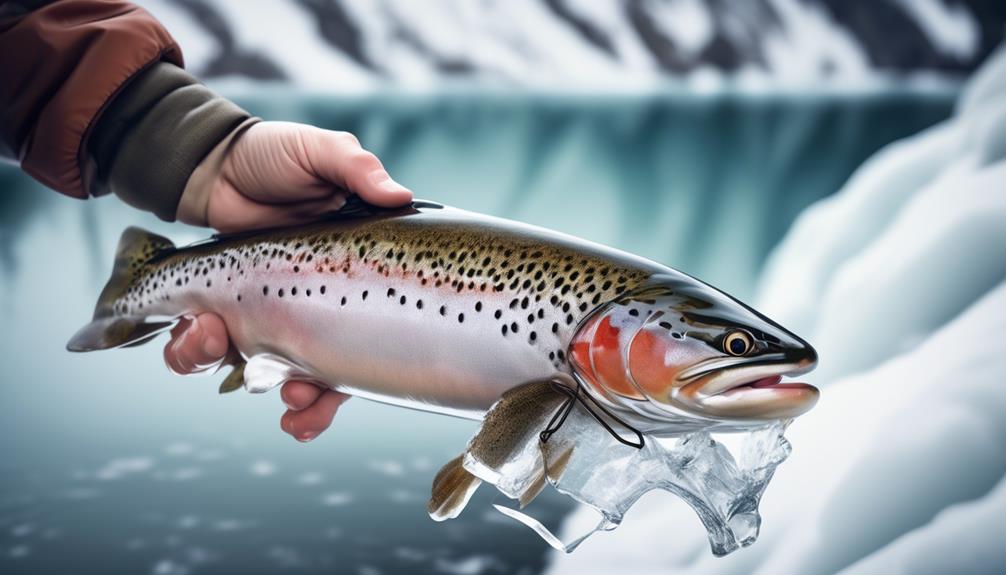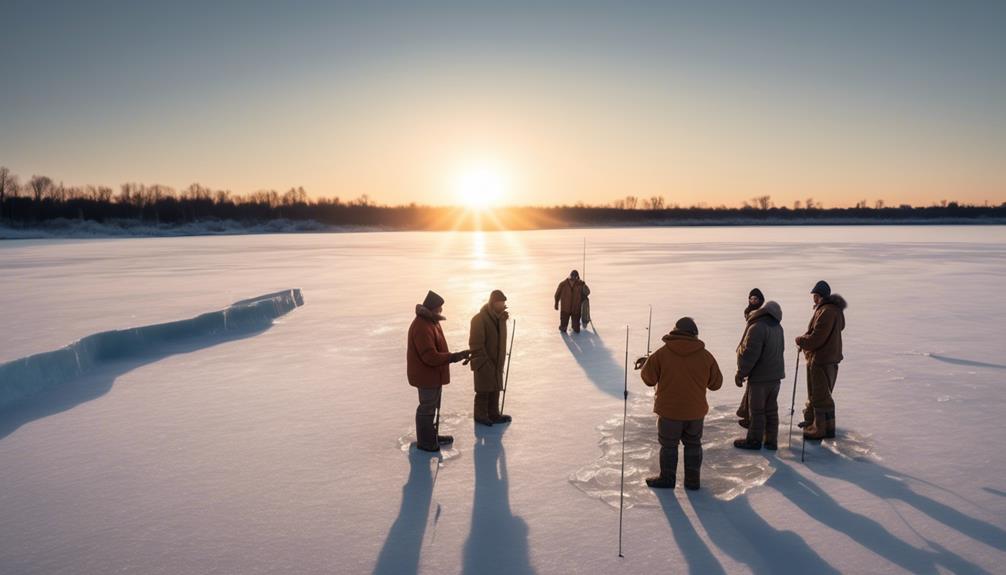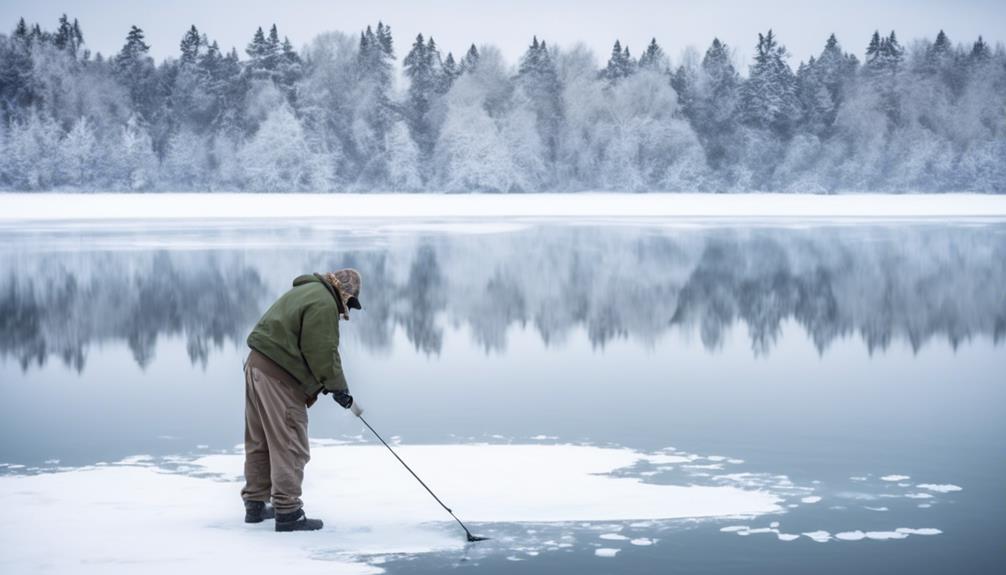Imagine the frozen mountain lake as a treasure trove waiting to be unlocked, the elusive trout hiding beneath the ice like precious jewels. As a beginner, stepping into the world of ice fishing for trout in the mountains can seem like a daunting task. But fear not, for with the right knowledge and preparation, you can embark on this icy adventure with confidence.
From choosing the perfect location to understanding the behavior of trout in winter, there are secrets to be unraveled that will increase your chances of a successful catch.
So, let's start by uncovering the first piece of this wintry puzzle – choosing the right location to begin your ice fishing journey.
Choosing the Right Location
To find the best location for ice fishing trout in the mountains, consider the depth and clarity of the water. When location scouting, environmental factors play a crucial role in determining the most suitable spots. Mountain terrain and altitude considerations also come into play when searching for the perfect ice fishing location.
First and foremost, when scouting for a location, it's essential to find areas with clear water and adequate depth. Trout tend to thrive in clear, cold water, so look for spots where the water is transparent and deep enough to support these fish during the winter months. Additionally, environmental factors such as the presence of natural food sources and the absence of pollutants should be taken into account. These elements contribute to the overall health and abundance of trout in a particular area.
Moreover, mountain terrain and altitude greatly influence the availability of suitable ice fishing locations. Higher altitudes often mean colder temperatures, which can impact the formation and stability of ice. Look for areas with consistent ice thickness and minimal snow cover to ensure safe and successful ice fishing. Additionally, consider the accessibility of the location, as steep or treacherous terrain may pose challenges when transporting gear and navigating the area.
Understanding Trout Behavior
When searching for the best ice fishing spot in the mountains, understanding trout behavior becomes crucial in targeting the most productive areas. Trout behavior is influenced by various factors such as feeding patterns, habitat preferences, seasonal movements, and water temperature.
- Feeding Patterns: Trout are most active during dawn and dusk when they feed more actively. Understanding their feeding patterns can help you plan your ice fishing trip during these peak times.
- Habitat Preferences: Trout prefer areas with cover such as fallen trees, rocks, and underwater vegetation. These spots provide them with protection and a place to ambush their prey.
- Seasonal Movements: Trout tend to move to deeper waters in the summer to find cooler temperatures, while they move to shallower areas in the winter. Understanding their seasonal movements can help you anticipate where they'll be during different times of the year.
- Water Temperature: Trout are sensitive to water temperature. They thrive in cold water and tend to be more active when the water is cooler. Therefore, targeting areas with cooler water temperatures can increase your chances of a successful ice fishing experience.
Essential Gear and Equipment
Equip yourself with the essential gear and equipment needed for a successful ice fishing excursion in the mountains.
First and foremost, invest in a sturdy ice shelter to protect yourself from the harsh mountain conditions. A portable ice shelter provides a warm and comfortable environment, shielding you from wind and snow while allowing you to focus on the thrill of ice fishing. Look for a shelter that's easy to set up and offers sufficient space for you and your gear.
Next, ensure you have a reliable fishing rod specifically designed for ice fishing. Ice fishing rods are shorter than traditional fishing rods, typically around 24 to 36 inches in length, allowing for easier maneuvering within the confines of an ice shelter. Opt for a rod with a sensitive tip that can detect subtle bites from trout in the icy waters. Pair your fishing rod with a quality reel that performs well in cold conditions, enabling smooth line retrieval even in freezing temperatures.
In addition to these essentials, pack ice augers to drill through the thick ice and create fishing holes, a selection of ice jigs and lures to attract trout, and a portable heater to keep warm inside the shelter. It's crucial to dress in layers and have insulated waterproof boots to stay comfortable during extended periods on the ice.
With the right gear and equipment, you'll be fully prepared to embark on an unforgettable ice fishing adventure in the mountains.
Safety Precautions on Ice
Before venturing onto the ice to fish for trout in the mountains, ensure your safety by taking necessary precautions. Ice fishing can be an enjoyable and rewarding experience, but it's crucial to prioritize safety.
Here are some essential safety precautions to consider:
- Check Ice Thickness: Always ensure the ice is thick enough to support your weight. A minimum of 4 inches of clear, hard ice is generally considered safe for ice fishing. However, ice thickness can vary, so use an ice auger or spud bar to test the thickness as you move onto the ice.
- Emergency Preparedness: Equip yourself with essential safety gear, including ice picks, a throw rope, and a life jacket. These items can be crucial in the event of an emergency, such as falling through the ice. Additionally, consider carrying a first aid kit and a fully charged cell phone in a waterproof container.
- Buddy System: Whenever possible, don't go ice fishing alone. Bring a friend or family member along and keep an eye on each other while on the ice. In the event of an emergency, having someone there to assist can be a lifesaver.
- Stay Informed: Stay updated on weather conditions and ice safety guidelines for the area where you plan to fish. Be aware of any potential hazards such as thin ice, cracks, or changes in weather that could affect ice stability.
- Know the Area: Familiarize yourself with the ice fishing location. Be aware of any known danger spots, such as areas with strong currents or underwater hazards.
Techniques for Catching Trout
To increase your chances of a successful trout catch while ice fishing in the mountains, consider employing a variety of effective techniques.
Bait selection is crucial when it comes to ice fishing for trout. Live bait such as minnows or worms can be highly effective in attracting trout. Additionally, artificial baits like small jigs, spoons, or soft plastic lures can also be successful, especially when tipped with a small piece of bait to add scent and flavor.
When it comes to ice fishing techniques, one popular method is jigging. This involves using a small jig or bait and moving it up and down in the water to mimic the movement of prey. Varying the speed and depth of your jigging can help entice trout to bite.
Another effective technique is using a tip-up, which is a device that suspends the bait at a predetermined depth below the ice. When a trout takes the bait, the flag on the tip-up will pop up, signaling that it's time to set the hook.
It's important to remember that trout can be sensitive to noise and vibrations, so try to minimize any disturbances on the ice. Additionally, paying attention to the water depth and temperature can also increase your chances of a successful catch.
Tips for Ice Fishing Success
When aiming for ice fishing success in the mountains, remember that the right bait selection and effective techniques can greatly increase your chances of catching trout. However, there are other crucial factors to consider to ensure a successful ice fishing trip.
First and foremost, always prioritize safety by checking the ice thickness before venturing out. The recommended ice thickness for ice fishing is at least 4 inches, but it should be 6-8 inches for a small group. Additionally, staying informed about the weather conditions is essential. Sudden changes in weather can affect the stability of the ice, so be sure to keep an eye on the forecast and be prepared to adapt your plans accordingly.
Here are some key tips for maximizing your success while ice fishing for trout in the mountains:
- Safety First: Always check the ice thickness before heading out and ensure it's safe for ice fishing.
- Weather Awareness: Stay updated on the weather conditions to anticipate any changes that may affect the ice.
- Proper Equipment: Invest in high-quality ice fishing gear, including an ice auger, shelter, and warm clothing.
- Bait Selection: Experiment with different bait options to determine what works best for enticing trout in your specific location.
- Patience and Persistence: Ice fishing can sometimes be a waiting game, so remain patient and persistent while monitoring your lines.
Proper Handling and Release

Ensuring the proper handling and release of trout after catching them is critical for maintaining their well-being and preserving the ecosystem. Trout conservation is essential for sustaining healthy populations, and practicing catch and release techniques is a responsible way to contribute to this effort.
When handling trout, it's crucial to minimize stress and injury to the fish. Always wet your hands before touching them to avoid removing their protective slime layer, which can make them more susceptible to infections. Additionally, handle the fish gently and support its body properly to prevent any harm.
When releasing trout back into the water, it's important to do so with care. Hold the fish upright in the water and allow it to regain its strength before swimming away. If the fish appears lethargic, gently move it back and forth in the water to help oxygen flow through its gills. It's also advisable to release the trout in the same area where it was caught, as this ensures it's returned to its familiar habitat.
Practicing catch and release techniques not only contributes to trout conservation but also allows for sustainable fishing experiences. By handling and releasing trout properly, you're helping to maintain the balance of the ecosystem and ensuring that future generations can continue to enjoy the sport of ice fishing for trout in the mountains.
Regulations and Permits
Before heading out for ice fishing in the mountains, make sure to familiarize yourself with the relevant regulations and obtain the necessary permits. Adhering to the local regulations is crucial for preserving the natural habitat and ensuring a sustainable fishing environment. Here are some key points to consider when it comes to regulations and permits:
- Permit Requirements: Different locations may have specific permit requirements for ice fishing. Ensure you're aware of these and obtain the necessary permits before heading out. Failure to comply with permit regulations can result in fines or other penalties.
- Local Regulations: Familiarize yourself with the local regulations governing ice fishing in the mountain area. These regulations may include restrictions on the type and size of fish that can be caught, as well as guidelines for catch-and-release practices.
- Fishing License: Make sure to have a valid fishing license for the specific area where you plan to ice fish. This is a fundamental requirement and may have seasonal restrictions or specific conditions based on the type of license obtained.
- Seasonal Restrictions: Be aware of any seasonal restrictions that may apply to ice fishing in the mountain region. Certain times of the year may have specific regulations in place to protect spawning fish or sensitive habitats.
- Conservation Efforts: Stay informed about any ongoing conservation efforts or special regulations aimed at preserving the local trout population. Being mindful of conservation initiatives is essential for maintaining the ecological balance of the area.
Frequently Asked Questions
How Can I Tell if the Ice Is Safe to Fish On?
Before heading out to fish, check the ice thickness, at least 4 inches for safety. Look for clear blue ice, which is the strongest. Bring essential safety precautions and appropriate fishing equipment for a successful trip.
What Should I Do if I Catch a Trout That Is Too Small to Keep?
If you catch a trout that's too small to keep, it's best to practice catch and release. Releasing small trout helps with fish conservation and ensures they have a chance to grow and reproduce for future fishing.
Are There Any Specific Regulations for Ice Fishing for Trout in Mountainous Areas?
Before heading out for ice fishing in mountainous areas, it's essential to understand the specific regulations in place. These regulations aim to conserve trout populations and minimize the environmental impact of ice fishing in such terrain.
Can I Use Live Bait When Ice Fishing for Trout?
Yes, you can use live bait when ice fishing for trout. Alternatively, artificial lures are also effective. Remember to follow ice fishing safety precautions. Always check local regulations and be cautious of thin ice.
What Should I Do if I Accidentally Fall Through the Ice While Ice Fishing?
If you accidentally fall through the ice while ice fishing, remember ice safety first. Stay calm, try to pull yourself out onto the ice where you fell through, and then follow emergency procedures immediately.
Conclusion
Now that you have the basics down, get out there and give ice fishing for trout in the mountains a try! Remember to choose a safe location, understand trout behavior, and use the right gear.
Be sure to follow safety precautions and regulations, and always handle and release trout properly.
With these tips and techniques, you'll be well on your way to a successful and enjoyable ice fishing experience. Good luck!



